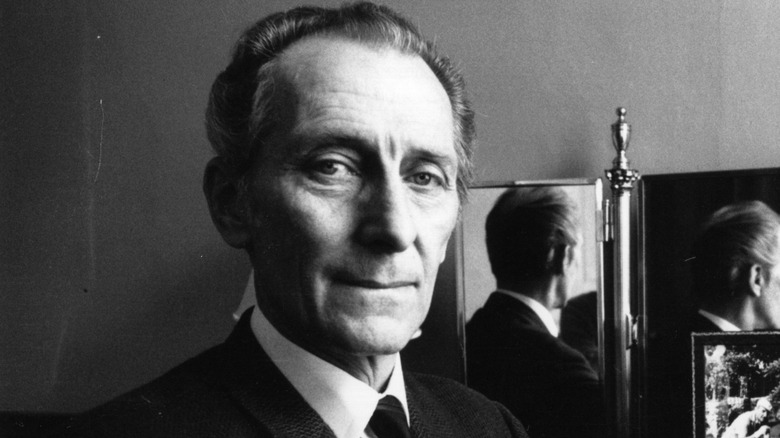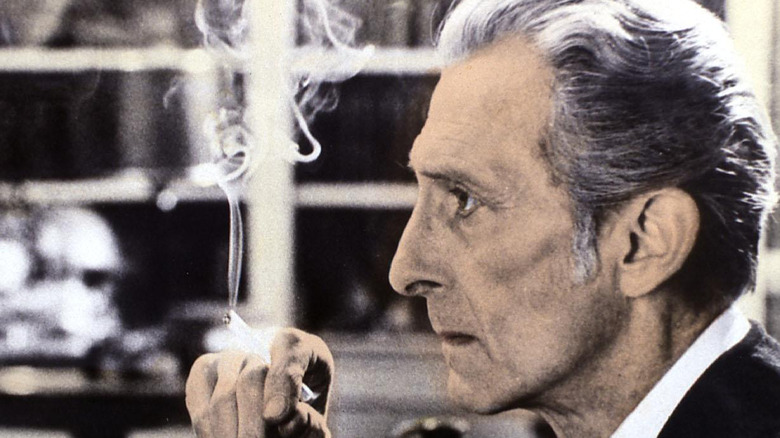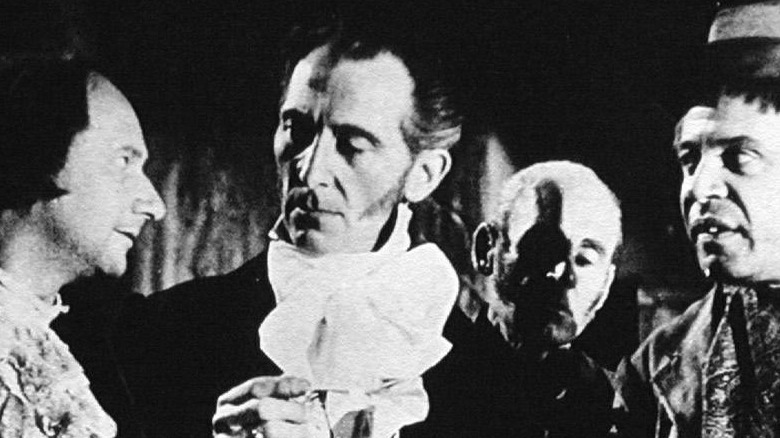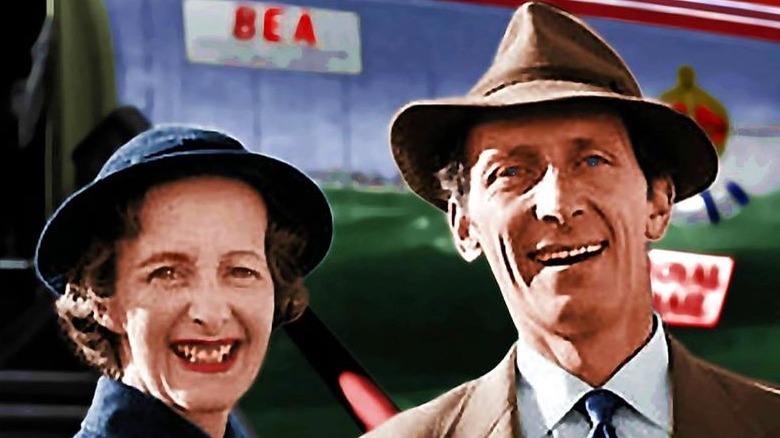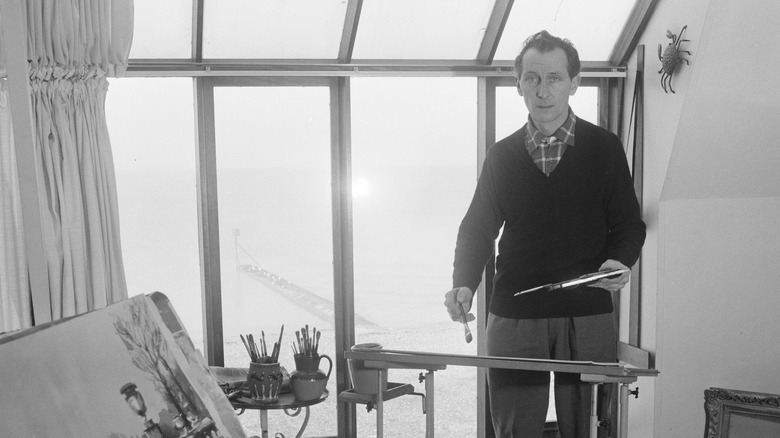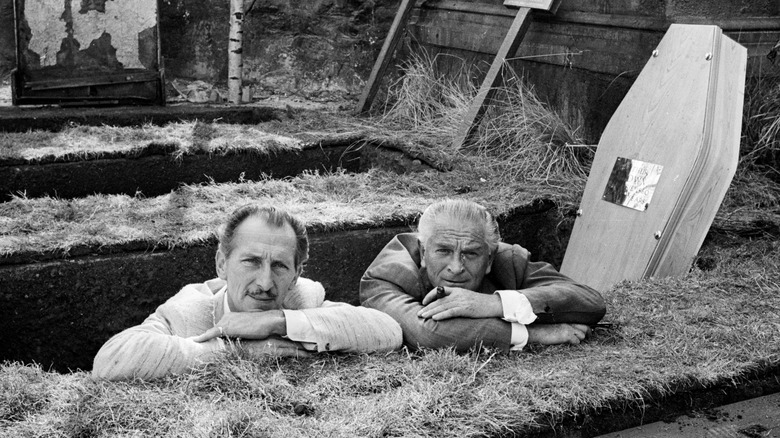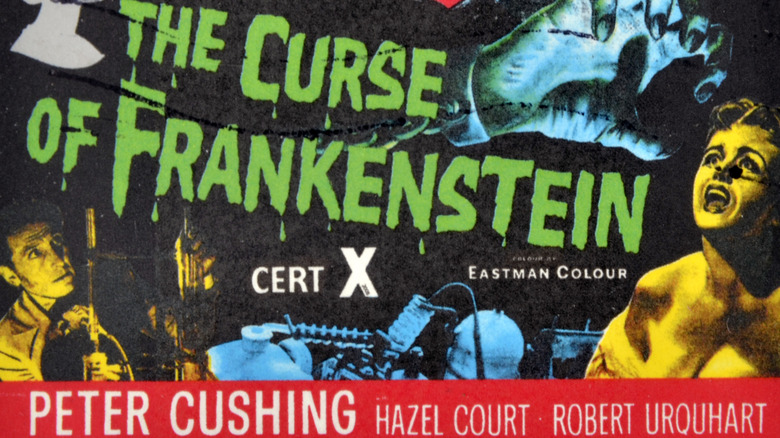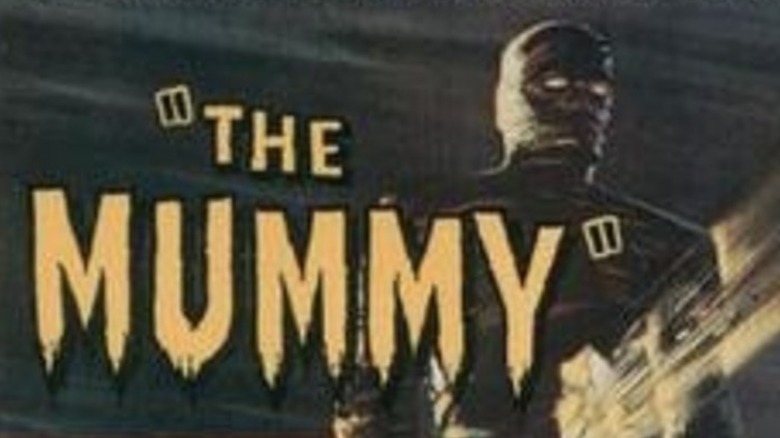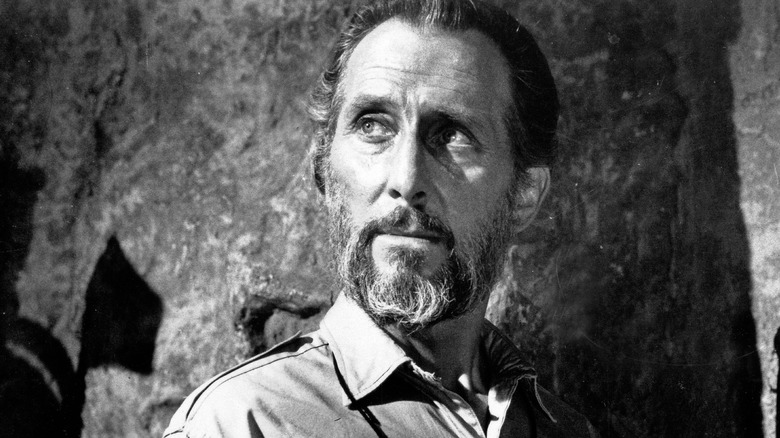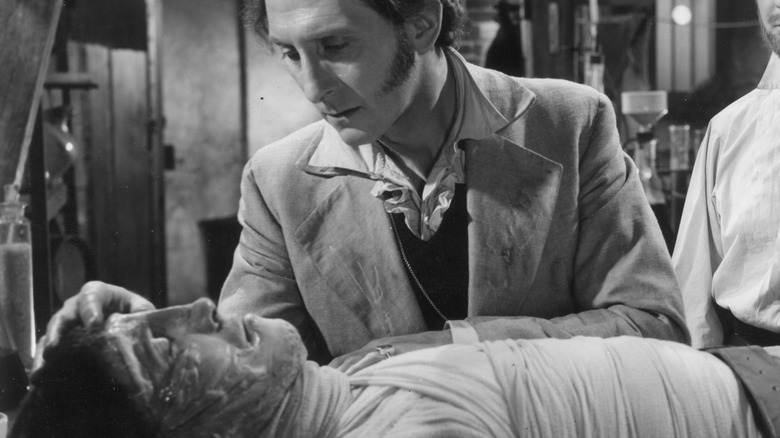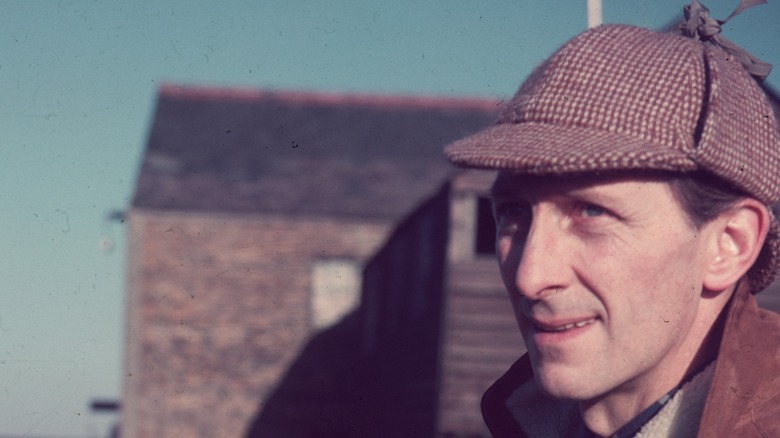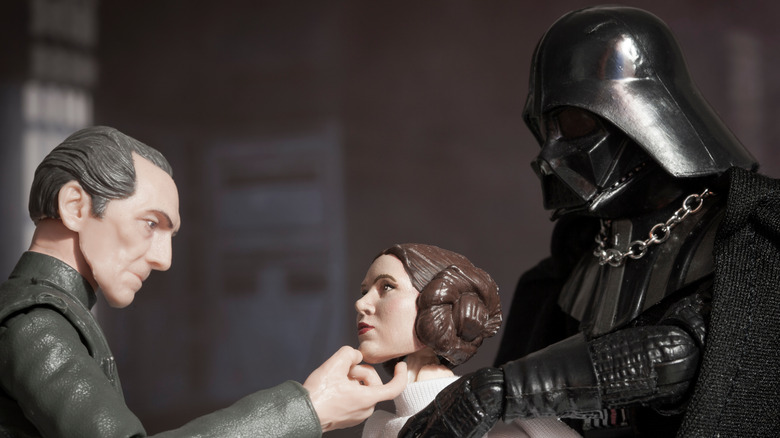The Untold Truth Of Peter Cushing
Hammer Films and their gory low-budget horror movies changed the trajectory of horror forever. Even in subsequent decades, as horror has gained more respect as a genre and horror films are often high-budget and award-winning, Hammer horror films have remained favorites. One explanation for why these films have endured is that alongside their blood-soaked vampires and dangerous vixens were complex performances — particularly from frequent star Peter Cushing.
"Peter Cushing gets every inch of drama from the leading role, making almost believable the ambitious urge and diabolical accomplishment," a reviewer (via Turner Classic Movies) stated of Cushing's performance in his very first Hammer Film, "The Curse of Frankenstein."
Cushing's journey to cult stardom was not an easy one, and he was forced to take many other jobs before finally finding his breakout role. "I wasn't cut out for office life," Cushing explained in a 1973 interview. "I always wanted to be an actor."
He was already middle-aged when he was cast as the villainous Victor Frankenstein by Hammer Films — a role that would establish Cushing's place in horror history. He would go on to appear in over 100 films and take on beloved genre roles — from Sherlock Holmes to Grand Moff Tarkin. Here is the untold truth of Peter Cushing.
Family and a childhood phobia
Peter Cushing first became famous for his work in often grisly horror films, but the star himself was nothing like the parts he played for Hammer Films. He personally didn't enjoy watching horror films and was afraid of the dark.
Cushing described the origin of these fears in his autobiography. While his parents were never violent, they had their own bizarre versions of discipline. His mother accidentally instilled in him "a morbid and quite unnecessary fear of death," by pretending to be dead whenever he was "naughty." As a punishment, Cushing's father once locked him in a completely dark basement alone, with "unspeakable horrors lurking in every nook and cranny."
This incident caused nightmares and an intense fear of the dark. As an adult, Cushing conquered his "nyctophobia" by going for long walks alone after midnight, "purposefully choosing byways which led through lonely labyrinths" to test the boundaries of his fear. Eventually he came to enjoy his long, solitary walks at night.
Cushing also had a brother, but in adulthood they did not see each other. According to a 2002 interview with Cushing's lifelong friend Christopher Lee, Cushing's brother married a woman who did not approve of actors.
Peter Cushing's Accent
Like his contemporaries Christopher Lee and Vincent Price, Peter Cushing's voice has been one of his most recognizable traits. When he first started acting in school plays, however, he sounded completely different — and it almost hindered his acting career.
After graduating, Cushing applied for an acting scholarship in London, but his regional accent was so strong that the interviewer believed Cushing was putting it on, urging him to use his "normal voice." As noted by Robert Pohl in "Sherlock Holmes on the Screen," he was even tutored at the school but was eventually kicked out because of the way he spoke.
Cushing developed his own method of training his voice. He would walk outside, shouting his lines as loudly as he could. Through this strategy, Cushing acquired the "faultless film diction" that he would become known for. Even after he had become a success, Cushing still preferred to memorize his lines by shouting them at full volume outdoors.
Peter Cushing's Wife Helen
Peter Cushing's life was largely defined by his relationship with his beloved wife, Helen. Today, she is perhaps best remembered for the rose he created in her honor.
As detailed in Peter Cushing's autobiography, Helen's family came to England after the fall of Tsarist Russia, taking the family from wealth to poverty. Helen was able to quickly learn how to survive and thrive on her own, from speaking four languages to learning to cook and sew, doing "everything superbly." Helen became a showgirl, was left by her first husband, and survived the London Blitz before she became Peter Cushing's wife — which she believed was her life's purpose.
When the two were married, they had only about 53 shillings between them — the modern day equivalent of less than $25. Helen sold everything she had brought from Russia. The couple couldn't stand to be apart and realized if they were both pursuing acting roles, they would have less time to spend together, maybe even in different cities. Eventually, Helen decided to stop looking for work in theater and instead devote her time to helping her husband find and prepare for roles. Others in entertainment, such as playwright Ronald Millar (who at one time slept in the Cushing's bathtub) came to rely on Helen Cushing's advice on their work.
Even with Helen's help and encouragement, it took Peter some time to become successful. He was able to get roles in London productions, but they were not enough to support himself and his wife.
Silk painting for survival
Although Peter Cushing is famous for his acting career, he was also a visual artist. When Peter was younger, he was employed painting the scenery for stage shows.
While Peter was struggling to find work, he and his wife could barely afford rent. Despite this, Peter still wanted to give Helen a Christmas present. Since he couldn't afford to buy one, he turned to his artistic abilities to create a gift. According to Peter Cushing's autobiography, he took a piece of silk that Helen's family had smuggled out of Russia. He painted Charles Dickens characters onto it and gave it to Helen as a scarf. It was so successful that he learned how to screen print and began designing scarves professionally. One of his designs was even worn by the queen mother.
Even after his success, he continued to paint and draw, even working as an illustrator. As noted by Robert Pohl in "Sherlock Holmes on Screen," in 1958 Peter Cushing's watercolors were exhibited in London.
'The Gentle Man of Horror'
In the late 1950s, the British film production company Hammer Films signed Peter Cushing. This would prove to be the defining moment of both Cushing's career and the legacy of Hammer.
Hammer had already found success in a few sci-fi films when the company decided to turn its attention to horror. As noted by Britannica, the new films would be full of monsters, gore, and beautiful women. Cushing, and his co-star and friend Christopher Lee, would star in dozens of these films and take on classic horror roles, from Frankenstein to Dracula. These roles made both men famous, and their performances made the low-budget films internationally successful.
After years of struggle, Cushing was famous. Despite the violence of the Hammer Films that Cushing starred in, he himself was always known as a respectful and kind individual. As Turner Classic Movies stated, he was known to his fans as "the gentle man of horror."
Cushing himself never thought of the movies he made as horror. "Horror to me is, say, a film like 'The Godfather.' Or anything to do with war, which is real and can happen unfortunately," Cushing stated in a 1973 interview. "The films that dear Christopher Lee and I do are really fantasy ... I don't object to the term 'horror,' it's just the wrong adjective."
Victor Frankenstein: Hammer's Villain
Peter Cushing often played heroes, like Van Helsing, in Hammer horror films, but one of Cushing's most famous roles was a villain — the twisted-genius Victor Frankenstein.
There were many films in Hammer's Frankenstein series, including the infamous "Frankenstein Must Be Destroyed!" As noted in John Kenneth Muir's "Horror Films of the 70s," this film takes the character of Victor Frankenstein from a cold individual who was willing to ignore the rules of normal morality to achieve his scientific goals to lust-fueled attacker. While Cushing's performance in the film was praised, the actor did everything he could to have the scene removed from the film.
As quoted in David Huckvale's "Touchstones of Gothic Horror," actress Veronica Carlson was extremely uncomfortable filming a sexual assault scene, which she described as "the most horrendous thing." Both Carlson and Cushing tried to argue with the studio and have the attack cut from the script, but ultimately they were forced to perform the scene as written. After the scene was finished, Carlson stated that, "Peter and I just stayed there and held onto each other. We felt very bad about it."
How Peter Cushing Shaped an Iconic Scene in The Mummy
While Peter Cushing was unable to change the script in "Frankenstein Must Be Destroyed!" he was able to add a key moment to "The Mummy," creating one of the most iconic moments in horror cinema.
As detailed in "Flesh & Blood – The Hammer Heritage of Horror," Cushing had seen the promotional poster that had been advertised to drum up support for the new film. It featured an image of the mummy with a hole through the chest and a beam of light shining through it. The script, however, didn't include any such scene. Cushing felt this was cheating the audience.
He devised a stunt in the climactic scene in which his character, John Banning, battled the mummy (played by Christopher Lee.) He seized a harpoon displayed on the wall of the study and thrust it through the mummy's chest — only to have the mummy break off the end of the harpoon and continue the battle like he had never been impaled.
How Peter Cushing Got His Nickname
Stabbing the mummy with a harpoon may be the most memorable example of Peter Cushing utilizing the set to make a scene more dynamic, but it's far from the only one.
Cushing was famous for having "business" in his scenes — constantly making the character feel alive even when he didn't have dialogue in the scene by interacting with the environment. As noted by AMC, he was nicknamed "Props" Cushing, for his tendency to pick up a random prop from the set and use it.
Director Val Guest, as quoted in "Hammer Films: the Bray Studio Years" (via Peter Cushing Appreciation Society), explained that the cast and crew of his film "The Abominable Snowman" were constantly amused by Cushing on set, because he "was forever coming out with props. When he was examining the Yeti tooth, he was pulling these things out totally unrehearsed and we found it very difficult keeping quiet."
Christopher Lee and Peter Cushing
Christopher Lee (also famous for films like "Lord of the Rings" and "Star Wars," and being Hammer's Dracula and Frankenstein's Creature) made more than 20 films with Peter Cushing. While they frequently played characters locked in mortal struggle, they were close friends in real life. According to a 2002 interview with Lee, the two often went to see cartoons together and even did impressions of Looney Tunes characters to make each other laugh.
Lee has described the many letters Peter Cushing sent him. Each one ended with "As ever, our love, Helen and Peter." Even after Helen Cushing's death, Peter Cushing continued to sign her name on his letters to Lee.
Peter considered his wife Helen's death in 1971 to be the end of his own life (although he would live until 1994) and even ended his autobiography at her time of death. Peter attempted suicide, and as described by Lee, he "only waited ... to join her. It was all he thought about."
Peter would return to acting, however. One of these films was "Horror Express," which co-starred Lee. As noted by the Peter Cushing Appreciation Society, Peter Cushing almost pulled out of the film, as Christmas was approaching and it would be his first without Helen. Many believe that Lee convinced Peter to stay, and that they may have spent that holiday together. "Horror Express" is one of the few films where the two play characters who are on the same side, rather than being rivals.
Three-time Sherlock Holmes
"He's the most devilish, difficult part to play," Cushing said of Sherlock Holmes. "It's so difficult to make him not seem so irritatingly mannered and insufferably conceited."
As tricky as Cushing found portraying Holmes, it was one of the roles he was most proud of. As detailed in "An Actor and a Rare One: Peter Cushing as Sherlock Holmes," Cushing was a lifelong fan of Sir Arthur Conan Doyle.
The first time Cushing played the consulting detective was for Hammer Films' "Hound of the Baskervilles." The film was quite different from the original novel and played up the horror elements for promotions — though Cushing convinced the producer to keep the deerstalker cap.
Cushing is reported to have done extensive study for the role, determining how Holmes would dress, sit, and stand. He even added lines from Doyle's stories into the script. According to the Arthur Conan Doyle estate, he smoked a traditional Holmes pipe for the role, even though he personally hated the taste of tobacco, and would wash out his mouth with milk between takes. Cushing would go on to play Holmes twice more in a TV movie and an ongoing series, and even depicted the author Arthur Conan Doyle in the film "The Great Houdini."
The Lost Doctor Who
The Doctor of "Doctor Who" is one of the most popular science fiction heroes, and he has been depicted by many actors, thanks to the character's ability to "regenerate," changing his face and personality. In 1965 and 1966, Peter Cushing took on the famous role — but not for the long-running television show.
As noted by Nerdist, Peter Cushing played the Doctor in "Dr. Who and the Daleks" and "Daleks – Invasion Earth: 2150 A.D." These movies were possible because of Terry Nation, who had written for "Doctor Who." Legally, the productions could adapt anything that Nation had written himself. Unfortunately, they did not have not have the rights to the title character. They did, however, have the rights to the show's most iconic villains, The Daleks, which were Nation's creation.
Instead of a time travelling alien called "The Doctor," Cushing plays a human man named "Doctor Who," who has a home-built time travel machine (called Tardis, but not T.A.R.D.I.S. like the one in the TV series).
While these movies were very intentionally different from "Doctor Who," in 2018 the films were officially recognized in the Doctor Who canon by then-showrunner Steven Moffat. As detailed by SyFy, there is a scene in the novelization, "The Day of The Doctor," in which it is confirmed that the character The Doctor is a fan of Cushing's portrayal. "He loaned Peter Cushing a waistcoat for the second one," a character in the novelization explains. "They were great friends."
Star Wars in Slippers
In an interview about Peter Cushing's role in "Star Wars," Christopher Lee stated, "I remember ringing [Cushing] up ... and saying, 'What is a Grand Moff Tarkin?'" Cushing replied, "I haven't the remotest idea, dear boy."
Cushing was cast in the then-completely unknown upcoming science fiction film "Star Wars." Grand Moff Tarkin, who destroys Princess Leia's home planet, would become one of his best-remembered roles. "I was dressed rather like an Edwardian chauffeur," Cushing said of Moff Tarkin's look in a 1977 interview, "with a high collar ... and a pair of boots, riding boots."
It was those tight fitting boots that would be an issue for Cushing, whose feet were over 12 inches long. The boots were not made specifically for Cushing, due to time constraints, and were much too small. Cushing described wearing them as "agony."
On the second day of filming, Cushing asked George Lucas to change the framing of some of the shots, so that he was only seen from the waist up. Lucas agreed. For the rest of the shoot, Cushing portrayed Grand Moff Tarkin in a pair of carpet slippers — which were never seen in the film.
